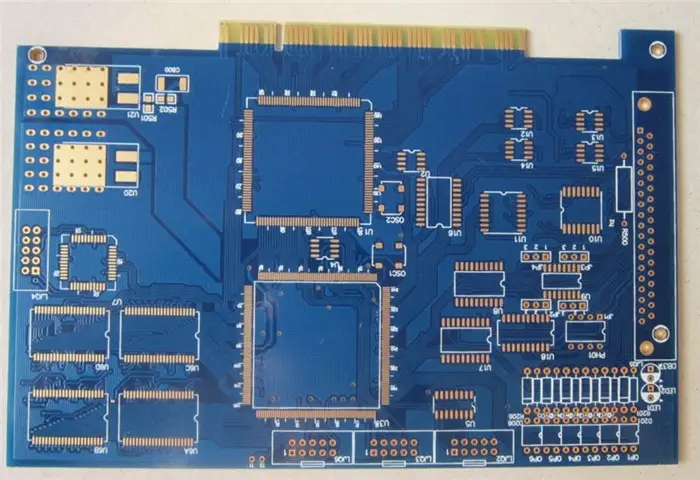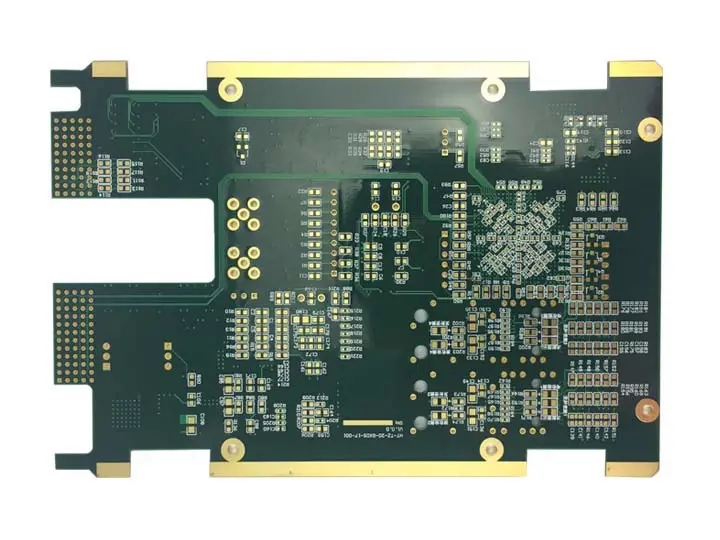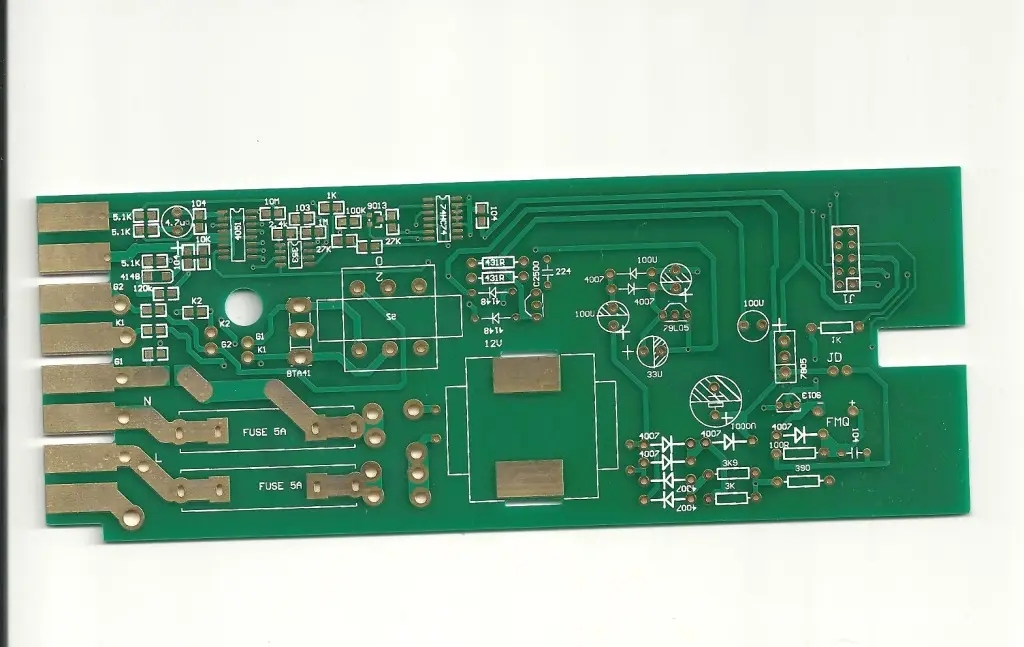
PCB manufacturers explain the partition design of PCB mixed signals in detail
PCB manufacturers, PCB designers and PCBA manufacturers explain the zoning design of PCB mixed signals
How to reduce the mutual interference between digital signals and analog signals? Two basic principles of electromagnetic compatibility (EMC) must be understood before design: the first principle is to reduce the area of current loop as much as possible; The second principle is that the system uses only one reference plane. On the contrary, if the system has two reference planes, it is possible to form a dipole antenna (Note: the radiation size of a small dipole antenna is proportional to the length of the line, the current flowing and the frequency); If the signal cannot return through the smallest loop as possible, a large loop antenna may be formed (note: the radiation size of the small loop antenna is proportional to the loop area, the current flowing through the loop, and the square of the frequency). These two situations should be avoided as much as possible in the design.
It is suggested to separate the digital ground and analog ground on the mixed signal circuit board, so as to realize the isolation between the digital ground and analog ground. Although this method is feasible, there are many potential problems, especially in complex large-scale systems. The most critical problem is that the wiring cannot cross the division gap. Once the wiring crosses the division gap, the electromagnetic radiation and signal crosstalk will increase dramatically. The most common problem in PCB design is the EMI problem caused by signal lines crossing the dividing ground or power supply.
We use the above segmentation method, and the signal line crosses the gap between the two grounds. What is the return path of the signal current? Assume that the two divided grounds are connected together at some place (usually at a single point at a certain position), in this case, the ground current will form a large loop. The high frequency current flowing through the large loop will generate radiation and high ground inductance. If the low level analog current flows through the large loop, the current is vulnerable to external signal interference. The worst thing is that when the split ground is connected together at the power supply, a very large current loop will be formed. In addition, analog ground and digital ground are connected together by a long wire to form a dipole antenna.
Understanding the path and mode of current return to ground is the key to optimize the design of mixed signal PCB. Many design engineers only consider where the signal current flows, ignoring the specific path of the current. If the ground wire layer must be divided and must be routed through the gap between the divisions, a single point connection can be made between the divided ground to form a connection bridge between the two grounds, and then the wiring can be routed through the connection bridge. In this way, a direct current return path can be provided below each signal line, so that the formed loop area is very small.
The optical isolation device or transformer can also be used to realize the signal crossing the separation gap. For the former, it is the optical signal that spans the segmentation gap; In the case of transformers, it is the magnetic field that spans the separation gap. Another possible approach is to use differential signals: signals flow in from one line and return from another signal line, in which case they are not needed as a return path.
In order to deeply discuss the interference of digital signals to analog signals, we must first understand the characteristics of high-frequency current. The path with the lowest impedance (inductance) and directly below the signal is always selected for high-frequency current, so the return current will flow through the adjacent circuit layer, regardless of whether the adjacent layer is the power layer or the ground layer.
In practical work, it is generally preferred to use a unified method, and divide PCB into analog part and digital part. Analog signals are routed in the analog area of all layers of the circuit board, while digital signals are routed in the digital circuit area. In this case, the digital signal return current will not flow to the ground of the analog signal.
Only when the digital signal is wired on the analog part of the circuit board or the analog signal is wired on the digital part of the circuit board, will the digital signal interfere with the analog signal. This kind of problem does not occur because there is no division. The real reason is that the wiring of digital signals is inappropriate.
PCB design adopts a unified approach. Through digital circuit and analog circuit zoning and appropriate signal wiring, it can usually solve some difficult layout and wiring problems, and it will not cause some potential troubles due to ground segmentation. In this case, the layout and partition of components become the key to determine the design quality. If the layout and wiring are reasonable, the digital ground current will be limited to the digital part of the circuit board and will not interfere with the analog signal. Such wiring must be carefully checked and checked to ensure 100% compliance with the wiring rules. Otherwise, a very good circuit board will be completely destroyed if a signal line is improperly routed.

When connecting the analog ground and digital ground pins of the A/D converter together, most A/D converter manufacturers will recommend that AGND and DGND pins be connected to the same low impedance ground through the shortest lead (Note: because most A/D converter chips do not connect analog ground and digital ground together internally, the connection between analog and digital ground must be realized through external pins), Any external impedance connected to the DGND will couple more digital noise to the analog circuit inside the IC through the parasitic capacitance. According to this suggestion, it is necessary to connect the AGND and DGND pins of the A/D converter to the analog ground, but this method will cause problems such as whether the ground terminal of the digital signal decoupling capacitor should be connected to the analog ground or the digital ground.
If the system has only one A/D converter, the above problems can be easily solved. Separate the ground and connect the analog ground and digital ground under the A/D converter. When this method is adopted, it must be ensured that the width of the connecting bridge between the two grounds is the same as that of the IC, and no signal line can cross the division gap.
If there are many A/D converters in the system, for example, how to connect 10 A/D converters? If the analog ground and digital ground are connected together below each A/D converter, the multipoint connection will be generated, and the isolation between analog ground and digital ground will be meaningless. If you do not connect in this way, it violates the manufacturer's requirements.
The best way is to start with a unified approach. As shown in Figure 4, it is uniformly divided into analog part and digital part. Such layout and wiring not only meet the requirements of IC device manufacturers for low impedance connection of analog and digital ground pins, but also avoid EMC problems caused by loop antennas or dipole antennas.
If you have doubts about the unified approach to mixed signal PCB design, you can use the method of ground wire layer division to layout and route the entire circuit board. During the design, you should pay attention to making it easy to use jumpers with spacing less than 1/2 inch or 0 ohm resistors to connect the divided ground together when the circuit board is tested at the rear. Pay attention to zoning and wiring, and ensure that no digital signal line is located above the analog part on all layers, and no analog signal line is located above the digital part. Moreover, any signal line shall not cross the ground gap or the gap between the split power supplies. To test the function and EMC performance of the circuit board, connect the two grounds together through a 0 ohm resistor or jumper, and retest the function and EMC performance of the circuit board. Comparing the test results, it can be found that in almost all cases, the unified scheme is superior to the split scheme in terms of function and EMC performance.
Is the method of land division still useful?
This method can be used in the following three situations: some medical devices require that the leakage current between the circuit and the system connected to the patient is very low; The output of some industrial process control equipment may be connected to electromechanical equipment with high noise and power; Another case is when the PCB layout is subject to specific restrictions.
There are usually independent digital and analog power supplies on the mixed signal PCB board, which can and should use a split power supply plane. However, the signal lines adjacent to the power supply layer cannot cross the gap between power supplies, and all the signal lines crossing the gap must be located on the circuit layer adjacent to a large area of ground. In some cases, the analog power supply is designed as a PCB connecting line instead of a plane to avoid the problem of power plane segmentation.
Mixed signal PCB design is a complex process, and the following points should be paid attention to in the design process:
1. Partition the PCB into independent analog part and digital part.
2. Suitable component layout.
3. The A/D converter is placed across partitions.
4. Do not divide the ground. The analog part and digital part of the circuit board shall be laid uniformly.
5. In all layers of the circuit board, digital signals can only be wired in the digital part of the circuit board.
6. In all layers of the circuit board, analog signals can only be wired in the analog part of the circuit board.
7. Realize analog and digital power division. 8. The wiring shall not span the gap between the divided power supply surfaces.
9. The signal lines that must cross the gap between the split power supplies shall be located on the wiring layer adjacent to the large area.
10. Analyze the actual flow path and mode of return ground current.
11. Use correct wiring rules.
PCB manufacturers, PCB designers and PCBA manufacturers will explain the zoning design of PCB mixed signals.







